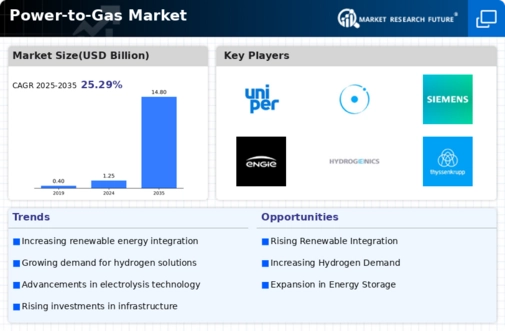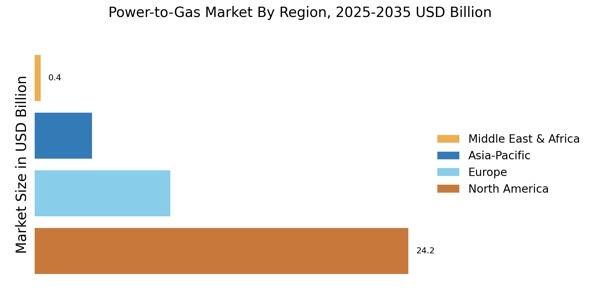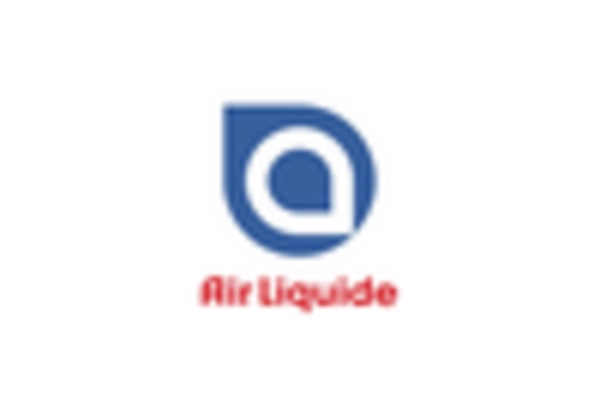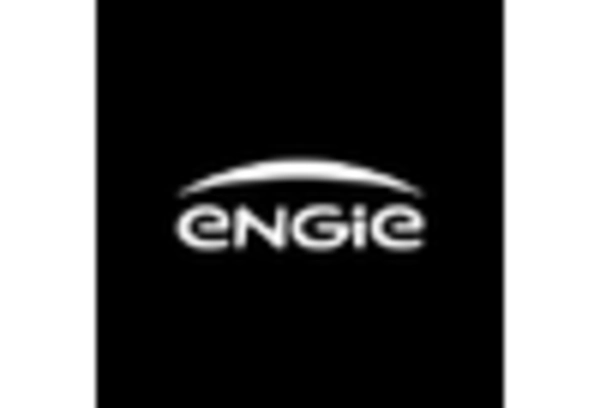Growing Focus on Decarbonization
The Power-to-Gas Market is significantly influenced by the growing focus on decarbonization across various sectors. As industries and governments strive to meet climate goals, there is an increasing recognition of the role that hydrogen can play in reducing carbon emissions. Power-to-Gas technology facilitates the production of green hydrogen, which can be utilized in hard-to-abate sectors such as transportation and heavy industry. Recent studies suggest that hydrogen could account for up to 24% of the total energy demand by 2050, underscoring its potential impact. This shift towards decarbonization is likely to drive investments in Power-to-Gas projects, thereby expanding the market and fostering innovation in hydrogen production and utilization.
Government Policies and Incentives
Government policies and incentives are increasingly shaping the landscape of the Power-to-Gas Market. Many countries are implementing supportive regulations and financial incentives to promote the adoption of clean energy technologies. For instance, various nations have established targets for reducing greenhouse gas emissions, which often include the integration of hydrogen production through Power-to-Gas systems. In some regions, subsidies and tax credits are available for projects that utilize this technology, thereby encouraging investment and innovation. The International Energy Agency has indicated that such supportive frameworks could lead to a substantial increase in the deployment of Power-to-Gas solutions, potentially doubling the market size by the end of the decade.
Rising Interest in Energy Diversification
The Power-to-Gas Market is benefiting from a rising interest in energy diversification among utilities and energy providers. As the energy landscape evolves, there is a growing recognition of the need to diversify energy sources to enhance resilience and security. Power-to-Gas technology allows for the conversion of surplus electricity into hydrogen or synthetic natural gas, which can be integrated into existing gas infrastructure. This capability not only provides a means of energy storage but also facilitates the blending of renewable gases with traditional natural gas supplies. Recent analyses indicate that energy diversification strategies could lead to a more stable energy supply, thereby increasing the attractiveness of Power-to-Gas solutions. This trend is likely to drive further investments and development within the Power-to-Gas Market.
Increasing Demand for Renewable Energy Storage
The Power-to-Gas Market is experiencing a notable surge in demand for renewable energy storage solutions. As the share of renewable energy sources, such as wind and solar, continues to rise, the need for effective energy storage systems becomes critical. Power-to-Gas technology offers a viable solution by converting excess renewable energy into hydrogen or synthetic natural gas, which can be stored and utilized later. According to recent data, the energy storage market is projected to grow significantly, with estimates suggesting a compound annual growth rate of over 20% in the coming years. This trend indicates a robust opportunity for the Power-to-Gas Market to play a pivotal role in balancing supply and demand, thereby enhancing grid stability and reliability.
Technological Innovations in Power-to-Gas Systems
Technological innovations are a key driver in the evolution of the Power-to-Gas Market. Advances in electrolysis technology, for instance, have significantly improved the efficiency and cost-effectiveness of hydrogen production. New methods, such as high-temperature electrolysis and proton exchange membrane technology, are being developed to enhance performance and reduce energy consumption. Furthermore, the integration of digital technologies, such as artificial intelligence and machine learning, is optimizing operational efficiencies in Power-to-Gas systems. These innovations not only lower production costs but also enhance the scalability of projects, making them more attractive to investors. As technology continues to advance, the Power-to-Gas Market is poised for substantial growth, potentially leading to widespread adoption of these systems.


















Leave a Comment